Vizzini
Vizzini is a town and comune in the Metropolitan City of Catania, on the island of Sicily, southern Italy. It is located 60 kilometres (37 mi) from Catania in the Hyblaean Mountains, on the most northwesterly slopes of Monte Lauro.
Vizzini | |
|---|---|
| Comune di Vizzini | |
 Panorama of Vizzini | |
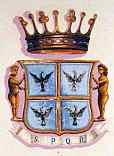 Coat of arms | |
Location of Vizzini 
| |
 Vizzini Location of Vizzini in Italy 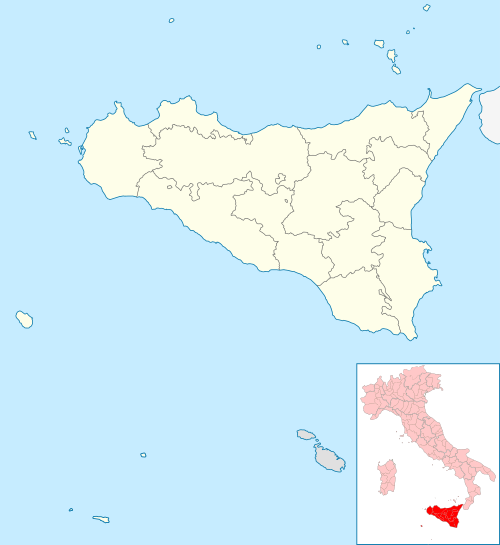 Vizzini Vizzini (Sicily) | |
| Coordinates: 37°10′N 14°45′E | |
| Country | Italy |
| Region | Sicily |
| Metropolitan city | Catania (CT) |
| Frazioni | Camemi, Vizzini Scalo |
| Government | |
| • Mayor | Vito Saverio Cortese |
| Area | |
| • Total | 125 km2 (48 sq mi) |
| Elevation | 586 m (1,923 ft) |
| Population (2018-01-01)[2] | |
| • Total | 6,330 |
| • Density | 51/km2 (130/sq mi) |
| Demonym(s) | Vizzinesi |
| Time zone | UTC+1 (CET) |
| • Summer (DST) | UTC+2 (CEST) |
| Postal code | 95049 |
| Dialing code | 0933 |
| Patron saint | St. Gregory |
| Saint day | 12 March |
| Website | Official website |
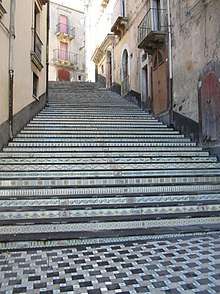
The commune territory is bounded by the comuni of Buccheri, Francofonte, Giarratana, Licodia Eubea, Militello in Val di Catania, Mineo.
History
Bidis, a Roman city mentioned by Pliny and Cicero, stood here in a territory that has been inhabited since prehistoric times.[3]
The modern town developed in the Middle Ages around a now non-extant castle,[4] as a fief of various lords, including the Chiaromontes and the Schittinos, although for many years it was also part of the royal domain.
In 1358, Roland of Sicily reconquered the area from Vizzini to Avola.
In 1415, the Jewish community of Vizzini was expelled by Queen Blanca, and was never permitted to return.
On the 14th of July, 1943 the town of Vizzini was liberated from fascist forces by the British military. Specifically, by that time Vizzini was occupied by a small detachment of forces from Nazi Germany. Britain's XXX Corps under General Montgomery consisting largely of M4 Sherman Tanks easily overpowered the small group of German tanks that were present in the town. The town had been in the American occupational zone and this caused some confusion when British forces liberated the town first.[5]
Main sights
The Arab layout of the town can be clearly seen passing from Via Verga to Via San Gregorio Magno and proceeding as far as Largo della Matrice, a square with a statue of St. Gregory in the middle and the Chiesa Madre (S. Gregorio Magno) at one side.
The portal on the left face of the church, in splendid 15th-century Gothic-Catalan style, probably came from the old Town Hall, destroyed by the earthquake in 1693; in the interior there are late 18th century stuccos and a wooden ceiling by Natale Bonaiuto, as well as two paintings (The Martyrdom of St. Laurence and the Madonna delle Mercede) by Filippo Paladini (or Paladino), born in Florence about 1544. Another painting by Paladino, The Deposition (1607), is in the Chiesa del Convento dei Cappuccini.
Nearby is the Chiesa di Sant'Agata, rebuilt in the 18th century on the site of a previous 15th-century building and houses a pipe organ[6] created around 1770.
The church of San Giovanni Battista is from the 18th century. The stuccos decorating the interior are by Natale Bonaiuto (also mentioned with reference to the Chiesa Madre).
The front of Chiesa S. Teresa is said to be the setting for scenes from Cavalleria Rusticana, the libretto of which is based on the play of the same name by Giovanni Verga, who lived in Vizzini for a time.
Antonello Gagini is present in the Chiesa dei Minori Osservanti, with a fine statue of the Madonna and Child (1527).
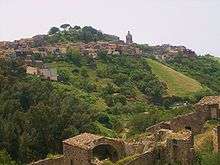
Religious buildings
- Chiesa dello Spirito Santo
- Chiesa di S. Maria di Gesù
- Chiesa di S. Vito
- Chiesa S. Annunziata
- Chiesa di S. Francesco di Paola
- Chiesa di S. Maria del Pericolo
- Chiesa S. Sebastiano
- Chiesa S. Teresa.
- Chiesa dei Minori Osservanti
- Chiesa di Sant'Agata
- Chiesa del Convento dei Cappuccini
- Monastero S. Maria dei Greci
- Santa Lucia
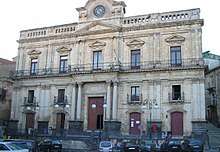
Palaces and other buildings
- Palazzo di Citta (early 19th century)
- Palazzo Verga (family of the writer)(18th century)
- Palazzo di città (municipio)(Town Hall Building)
- Palazzo Cannizzaro
- Palazzo Passanisi
- Palazzo Cafici
- Palazzo La Gurna
- Palazzo Trao
- Palazzo Gandolfo Maggiore
Culture
The writer Giovanni Verga used Vizzini as the setting for his Cavalleria Rusticana and Mastro Don Gesualdo, describing places and scenes that are still recognizable (the prickly pears of Cunziria, and in a sloping alley the house of the Trao family).
People
- Giovanni Verga (1840–1922), Italian realist writer.
- Lucio Marineo Siculo (1444–1533).[7][8] Humanists Scholar at the University of Salamanca, Spain, teacher of translating Italian love poetry, Latin, and Greek lyrics into Spanish. Lived in the court of the Spanish kings Ferdinand and Isabel where he taught Joan Boscà i Almogàver.[9]
Economy
The economy of the commune is mainly agricultural (cereals, prickly pears, vegetables, sumac). Other activities include handmade shoes and carpentry.
Transportation
Buses travel to and near Vizzini regularly from surrounding cities Catania and Ragusa. Major operators include AST and ETNA.
The railway station Vizzini-Licodia is situated 6 km outside the city in the frazione of Vizzini Scalo.
Events
- Procession of "Sorrows" – Good Friday
- "A Cugnunta" – Easter Sunday
- "Ricotta and Cheese Festival" – 23, 24 and 25 April
- Festival of San Giuseppe – 19 April
- "Festival of Taste and Odours" – 2 June
- Festival of San Giovanni Battista – 28 and 29 August
- Events Verghiane – July / August
- Festival of the Patron San Gregorio Magno – 2 and 3 September
- "Rocksticana[10] " – Rock music festival for emerging groups – September
- Traditional "Festival of the Dead" – 30–31 October and 1 November
- "Living Nativity" – December
See also
- Allied invasion of Sicily – during the Second World War Vizzini was captured on 14 July 1943.[11]
Twin towns



References
- "Superficie di Comuni Province e Regioni italiane al 9 ottobre 2011". Istat. Retrieved 16 March 2019.
- "Popolazione Residente al 1° Gennaio 2018". Istat. Retrieved 16 March 2019.
- Sicily and Its Islands, 2004 - Ugo La Rosa editore
- AA. VV., Castelli medievali di Sicilia - Guida agli itinerari castellani dell'isola, Grafiche Renna, Palermo 2001"VIZZINI - Denominazione: castello o torre di Vizzini; turris Bizini.Cartografia IGM: 273 II N.O. Vizzini. Dati catastali: Vizzini, F° 80, partt. 1847, 2049. Bibliografia essenziale:Amico 1855-56. II, pp. 663-66; Maurici 1992. p. 384; SMDS, VII, pp.80-83. C.M.B"
- Bitter Victory: The Battle for Sicily, July-August 1943 by Carlo D'Este, pg. 326-328
- Giusy Larinà -Towards a typology of decorative façades in 18th-century Sicilian organs (This article was published in Italian in Il Canto dell'Aquila, (Centro di Studi Musicali per il Meridione, Caltagirone) July 1990, pp102-111.)Photographs courtesy of Vincenzo Piluso.English translation by N. Waanders 2001 Archived 8 October 2007 at the Wayback Machine
- Joan Boscà i Almogàver was a student of Lucio Marineo Siculo from Vizzini, Italy
- Biblioteca Comunale "Lucio Marineo" Archived 3 July 2009 at the Wayback Machine
- JSTOR: Renaissance Quarterly, Vol. 50, No. 3 (Autumn, 1997 ), pp. 701-722:# Marineo Siculo: A Protagonist of Humanism in Spain(Erika Rummel)
- Rocksticana, concorso musicale per gruppi emergenti Archived 19 November 2008 at the Wayback Machine
- Biography: Bernard Law Montgomery: jewishvirtuallibrary.org
External links
- (in Italian)Official website of the Comune di Vizzini
- (in Italian)InfoVizzini.it – "The website of the Citizens of Vizzini"
- (in English)Vizzini Genealogy(Birth / Marriage / Death indices 1820-1860 / Military Draft Index 1840-1913)
- (in English)Towards a typology of decorative façades in 18th-century Sicilian organs (Page 3)(Page 4)
- (in English)B-26 320th Bomb Group 1943 Missions – 10 July 1943 – Vizzini (Sicily) (Mission No.44 No. Aircraft 22) – Scanned pdf copy of the Mission Summary and strike photo.
- (in English) Vizzini - A Small Sicily City